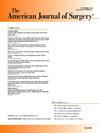微创手术后最佳端口皮肤闭合方法:随机临床试验的系统回顾和网络荟萃分析
IF 2.7
3区 医学
Q1 SURGERY
引用次数: 0
摘要
背景:对于微创手术(MIS),有许多可接受的端口闭合技术,但对使用的方法尚无共识。目的:从并发症发生率和美容效果方面,确定MIS术后最佳切口闭合方法。方法根据PRISMA-NMA指南进行网络荟萃分析(NMA),比较至少两种端口部位关闭方法的rct。结果共纳入19项随机对照试验,对1,932例患者的8种伤口闭合方法进行了评价;三种缝合线,三种组织胶,订书钉和纸带。在NMA,伤口并发症、感染、开裂或疼痛率与闭合方法无关,尽管粘接剂的开裂率有较高的趋势。在NMA术后早期和后期随访中,粘接剂的创面美容效果均优于粘接剂。结论:本研究验证了组织粘接剂在MIS术后港口部位初步关闭方面的使用,同时强调了潜在的相关风险。本文章由计算机程序翻译,如有差异,请以英文原文为准。
Optimal port site skin closure method following minimally-invasive surgery: A systematic review and network meta-analysis of randomised clinical trials
Background
For minimally-invasive surgery (MIS), there are numerous acceptable port-site closure techniques with no consensus on the method used.
Aim
To identify optimal port site postoperative wound closure method following MIS with respect to complication rates and cosmetic outcome.
Methods
Network meta-analysis (NMA) was performed in accordance with PRISMA-NMA guidelines for RCTs comparing at least two methods of port-site closure.
Results
Nineteen RCTs were identified evaluating eight methods of wound closure in 1,932 patients; across three types of suture, three forms of tissue glue, staples and paper-tape. At NMA, there was no significant difference in wound complication, infection, dehiscence or pain rate irrespective of closure method, albeit a trend towards higher rate of dehiscence for adhesives. At NMA, wound cosmesis was superior for adhesives at both early and late postoperative follow-up.
Conclusion
This study validates the use of tissue adhesives with respect to primary closure of port sites following MIS while highlighting potential associated risks.
求助全文
通过发布文献求助,成功后即可免费获取论文全文。
去求助
来源期刊
CiteScore
5.00
自引率
6.70%
发文量
570
审稿时长
56 days
期刊介绍:
The American Journal of Surgery® is a peer-reviewed journal designed for the general surgeon who performs abdominal, cancer, vascular, head and neck, breast, colorectal, and other forms of surgery. AJS is the official journal of 7 major surgical societies* and publishes their official papers as well as independently submitted clinical studies, editorials, reviews, brief reports, correspondence and book reviews.

 求助内容:
求助内容: 应助结果提醒方式:
应助结果提醒方式:


